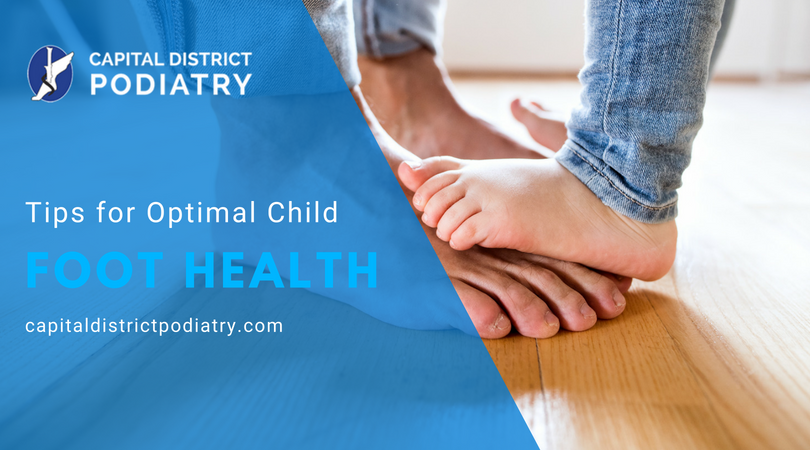How to Take Care of Your Kiddos’ Feet!
No matter who they are or where they live, all parents in the world definitely want two things—for their children to be healthy and happy.
The odds are pretty decent you don’t give this much thought, but a child’s feet are actually key elements in both health and happiness. And with that being the case, one of our goals at Capital District Podiatry is to give you the tools you need to keep your kids’ feet safe.
(Sure, you can certainly always feel free to contact us for an appointment so we can provide gentle, effective treatment for any pediatric foot or ankle issue, but we’re inclined to think you would simply prefer to know that your child didn’t have to experience a painful condition or lose interest in favorite activities in the first place!)
Between the two, health is probably easier to understand when it comes to benefits of child foot care. After all, feet are part of the body. But how does a child’s happiness relate to foot health? (Besides the fact that a child in pain is less likely to be happy, of course.)
Well, take a moment and think about the things that children usually enjoy doing—and particularly activities that aren’t centered around staring at a screen for hours!
We aren’t mind-readers here, but we’ll bet you’re thinking about kids playing and running around.
You might picture them in organized sporting activities or simply running around on playground and playing made-up games. Perhaps you can even see them smiling or hear the laughter that happens when children spend time doing fun things and spending time with friends.

And no matter if we’re talking about organized sports or simple playground fun, these kinds of physical activities play respective roles in early human development. In fact, developmental psychologists have established that “play” has an instrumental role in learning.
When foot or ankle injuries or conditions enter the picture, however, it can be rather difficult or outright painful for children to be active.
That’s a problem in several regards, so you will likely want to know how to protect your child’s feet. The good news is that there are a variety of relatively easy measures you can take to do exactly that!
Tips for Optimal Child Foot Health
To put your child in the best possible position for both health and happiness, you need to do things like:
- Provide proper footwear. It’s quite difficult to overstate the importance of wearing proper shoes for your child’s foot health. And by “proper,” we mean footwear that both fits correctly and is activity-appropriate.
Regarding correct fit, your first step is to back away from the computer if you need to buy your child new shoes. Instead, bring your son or daughter along with you to an actual brick-and-mortar shoe store. Why is this important? Because shoes that are too big and shoes that are too small can both cause problems.
To find shoes that fit your child well, you need to remember that shoe sizes aren’t the “be all, end all.” Yes, they provide a convenient guideline for knowing which pairs are probably close to the right size, but how shoes fit the feet is way more important. The reason for this is that shoe sizes aren’t exactly uniform across different brands. A size-5 from one company might actually be a 4 ½ from another.
Your child’s feet need to be measured. This is important because one foot is bound to be even a little bit bigger than the other. Shoes need to be purchased with the larger foot in mind.
There should be approximately a thumb’s width of space between the longest toe on the larger foot and the front of the shoe. When laced tightly, you should be able to slide your index finger down to about the second knuckle without it being too uncomfortable for your child.
When it comes to “activity-appropriate,” your daughter should wear basketball shoes (and not running shoes) if she plays basketball. Your son should wear soccer flats (not basketball shoes) if he plays soccer. Etc.

One final thought about children’s shoes is this—your kid’s feet grow quickly. This is necessary for continuing to support a growing body. And it means you may need to buy your child a couple of pairs of shoes during the year. When you do, make sure they fit at the time of purchase (and you aren’t planning on “he’ll grow into them” or “they’ll stretch out in time”)!
- Start a regular stretching routine. Out of the various lower limb issues people can experience, there are a good number which have a root cause of excessively tight tissues. In particular, the calf muscle, Achilles tendon, and plantar fascia are all major culprits.
Now, a child’s body tissues are typically more limber than your average adult’s, but you still want to make sure your kids are preventing injuries—and especially if they’re incredibly active—with a daily stretching routine.
This doesn’t have to be especially extensive—even about five minutes a day can be beneficial—but it reduces injury risk and, even better, establishes a great habit that will pay dividends when they get to be your age!
- Keeping feet clean. The biggest struggle with some children—at least, the biggest until the inevitable struggle for independence during the teen years—can be cleanliness. When it comes to keeping their feet clean, this is a battle you need to win. And victory is simply making sure they wash their feet daily.
Why is that important? Well, daily hygienic practices like this help to prevent fungal and bacterial infections. Those aren’t generally extremely common issues in early years, but (as with stretching) this habit will carry over into adulthood, when our bodies start becoming more susceptible to them.

Also, child and teen feet can stink! The offensive odor is often attributed to sweat, but sweat is actually odorless. The real cause is a matter of bacteria that digests sweat and releases odor as they break it down during the digestive process. Washing feet daily reduces the amount of odor-releasing bacteria and, in turn, makes your son or daughter’s footwear (and feet themselves!) easier to be around.
- Give them nutritious food. Hey, we know that out of the numerous health-related reasons you can think of for making sure your child eats their veggies (and whole grains, lean proteins, etc.), foot health probably isn’t even close to the top of the list. But the simple fact of the matter is that feet can stay strong, healthy, and capable of supporting the body when they receive essential nutrients—such as calcium and vitamin D for bone strength and protein for strong muscles.
In addition to providing your child’s musculoskeletal system with everything it needs for optimal functionality, a well-balanced diet is key for weight management. Yes, stronger feet are better able to support greater weight loads, but it’s just better for them not to have to absorb the extra force loads in the first place!
- Keep toenails trimmed – the right way. There are a handful of possible causes for ingrown toenails. One that tends to be fairly common when this issue affects children is how the nails were trimmed.
When toenails are clipped too short or the corners are rounded, they are more likely to become ingrown. Now, in all likelihood, the reason some people round them off is because that’s what we generally do with our fingernails, right?
For toenails, however, the best practice is to cut them straight across. And when you do, you should try to keep them roughly even with the edge of their respective toes, and not too short.
Whereas it’s quite beneficial to trim your child’s toenails the correct way, even better is also teaching them how to so they can handle it on their own (whenever they’re ready to start doing so).
Setting a Good Example
Those are all important measures for keeping your child’s feet healthy and safe. Something that is even more important is making sure that you’re setting a good example with your own foot care!
One good example you should definitely set for them is seeking professional help when it’s necessary—like contacting a podiatrist for any foot problems.
Hopefully you and your children are able to have healthy, safe feet, but remember that Capital District Podiatry is here to help if you need treatment. We provide effective care to resolve a wide range of podiatric issues, so don’t hesitate to call (518) 273-0053 or connect with either our Troy or Clifton Park offices online.
Troy Office
763 Hoosick Rd.
Troy, NY 12180
Clifton Park Office
855 Route 146 | Suite 150
Clifton Park, NY 12065
© Capital District Podiatry, LLC. All Rights Reserved.
Notice of Nondiscrimination | Privacy Policy | Terms & Conditions
